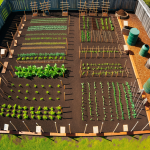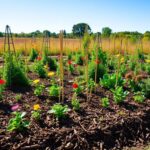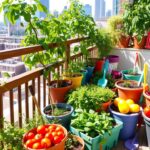Can you imagine growing a lush garden without synthetic fertilizers? It’s possible with homemade organic fertilizer. Making your own is simple and helps the planet. It also makes your plants healthier.
Starting with natural fertilizer recipes can transform your garden. We’ll show you how to make your own organic fertilizer. This guide will help you create a fertilizer that’s perfect for your garden.
Key Takeaways
- Learn how to make your own homemade organic fertilizer using easy diy methods
- Discover the benefits of using organic gardening tips and composting for beginners
- Understand the importance of natural fertilizer recipes for healthy plant growth
- Get started with simple and effective organic gardening techniques
- Reduce your environmental impact by using homemade organic fertilizer
- Create a thriving and sustainable garden with our expert tips and tricks
Understanding Organic Fertilizers and Their Benefits
Organic fertilizers come from natural sources and don’t have synthetic chemicals. This makes them a favorite among gardeners who care about the environment. They help improve soil health and boost crop yields. Using them also helps gardeners reduce their environmental impact and adopt sustainable gardening practices.
The environmental benefits of organic fertilizers are big. They cut down on synthetic chemicals in the environment. Plus, making your own fertilizer can save money. Gardeners can use household waste and natural materials to create their own.
What Makes a Fertilizer Organic
A fertilizer is organic if it’s made from natural stuff and doesn’t have synthetic chemicals. Examples include compost, manure, and green sand.
Environmental Benefits of Organic Fertilizers
Organic fertilizers help the environment a lot. They reduce soil pollution, improve water quality, and support biodiversity. Using them makes gardening more sustainable and good for plants and the planet.
Cost Advantages of Making Your Own
Creating your own organic fertilizer can save money and be eco-friendly. You can compost household waste, use animal manure, or make a worm composting bin.
| Organic Fertilizer | Benefits |
|---|---|
| Compost | Improves soil health, increases crop yields |
| Manure | Provides nutrients, improves soil structure |
| Green Sand | Improves soil fertility, increases crop yields |
Essential Nutrients in Organic Fertilizers
Organic fertilizers give plants the nutrients they need to grow well. These include nitrogen, phosphorus, and potassium. Nitrogen helps leaves grow, phosphorus supports roots, and potassium keeps plants healthy.
It’s important to have the right mix of these nutrients in organic fertilizers. Too little or too much can harm plants. This can cause stunted growth, yellow leaves, or poor fruit.
Using organic fertilizers with these nutrients has many benefits. They improve soil health, increase crop yields, and make plants more resistant to diseases. They also help keep the environment clean and prevent soil damage.
When picking an organic fertilizer, look for one with a balanced mix of nitrogen, phosphorus, and potassium. This ensures your plants get what they need to thrive. Organic fertilizers help create a healthy, sustainable garden that’s good for you and the planet.
Knowing about essential nutrients in organic fertilizers helps you choose better for your garden. Always follow the product label and avoid overfertilizing. With the right balance, your garden will flourish, giving you joy and fresh produce for years.
| Nutrient | Function | Deficiency Symptoms |
|---|---|---|
| Nitrogen | Leaf growth and development | Yellowing leaves, stunted growth |
| Phosphorus | Root development and fruit production | Poor fruit quality, weak roots |
| Potassium | Overall plant health and resistance | Weak stems, poor resistance to disease |
How to Make Organic Fertilizer at Home: A Complete Guide
Making organic fertilizer at home is easy and saves money. You need a bucket, shovel, and watering can to start.
Basic Equipment Needed
You likely have most of the tools at home. You might also want a compost bin, soil test kit, and measuring cup.
Choosing Your Ingredients
There are many ingredients for organic fertilizer. Compost, manure, green sand, and bone meal are good choices. Kitchen scraps like vegetable peels and coffee grounds also work well.
Step-by-Step Mixing Process
Just mix your ingredients in a bucket. Use 2/3 “brown” stuff like compost and 1/3 “green” stuff like kitchen scraps. Then, add it to your soil and water as usual.
Here’s a simple recipe to start:
- 2 cups compost
- 1 cup manure
- 1 cup green sand
- 1/2 cup bone meal
- 1/2 cup kitchen scraps
By following this guide, you can make your own organic fertilizer. Use the right ingredients for the best results.
| Ingredient | Quantity | Nutrient Value |
|---|---|---|
| Compost | 2 cups | Rich in nitrogen, phosphorus, and potassium |
| Manure | 1 cup | High in nitrogen and phosphorus |
| Green sand | 1 cup | Rich in iron and other micronutrients |
| Bone meal | 1/2 cup | High in phosphorus and calcium |
| Kitchen scraps | 1/2 cup | Rich in nitrogen and other micronutrients |
Kitchen Scraps as Natural Fertilizers
Kitchen scraps can be a great help for gardeners. They offer a natural and free way to fertilize plants. By composting these scraps, people can cut down on waste and make their soil better.
Items like fruit and veg peels, eggshells, and coffee grounds are good for plants. They have nutrients like nitrogen and potassium that plants need to grow. Adding these to compost makes a good fertilizer for gardens.
To start composting, follow these steps:
- Collect kitchen scraps in a bin or container
- Mix “green” materials (like fruit peels) with “brown” materials (like eggshells)
- Keep it moist and turn the compost often
Composting kitchen scraps helps reduce waste and makes a natural fertilizer. It’s a healthy way to garden.
Composting kitchen scraps is key to eco-friendly gardening. It helps the environment and makes soil better for plants. This method is simple and good for the planet.
Coffee Grounds and Eggshells: Nature’s Plant Food
Coffee grounds and eggshells are great for gardening. They are full of nutrients that help plants grow well. Coffee grounds add nitrogen and improve soil drainage.
Benefits of Coffee Grounds
Coffee grounds are packed with nitrogen, phosphorus, and potassium. They make the soil more acidic, which is good for azaleas and blueberries. They also make the soil better for water and help plants grow.
Using Eggshells Effectively
Eggshells are good for the soil when crushed and added. They have calcium, which plants need. They also help fight pests like slugs and snails.
Some of the best plants for coffee ground fertilizer include:
- Azaleas
- Blueberries
- Roses
- Tomatoes
Using coffee grounds and eggshells is a smart way to help plants grow. It’s also good for the environment. Adding these to your garden makes it more sustainable.
Here is a table summarizing the benefits of using coffee grounds and eggshells as fertilizer:
| Material | Benefits |
|---|---|
| Coffee Grounds | High nitrogen content, improves soil structure, increases water-holding capacity |
| Eggshells | Good source of calcium, improves soil structure, provides natural barrier against pests |
Banana Peels: The Ultimate Plant Superfood
Banana peels are packed with nutrients like potassium, magnesium, and sulfur. They are great for fertilizing plants naturally. Using banana peels helps your plants grow strong and improves the soil.
There are many ways to use banana peels in your garden. You can bury them in the soil or mix them into compost. Or, dry and grind them into a powder for a homemade fertilizer. Banana peels work well for many plants, from flowers to veggies.
Here are some tips for using banana peels in your garden:
- Bury the peels around the base of your plants to provide a slow release of nutrients.
- Add the peels to your compost pile to create a nutrient-rich soil amendment.
- Use the peels as a natural pest repellent to keep aphids and other pests away from your plants.
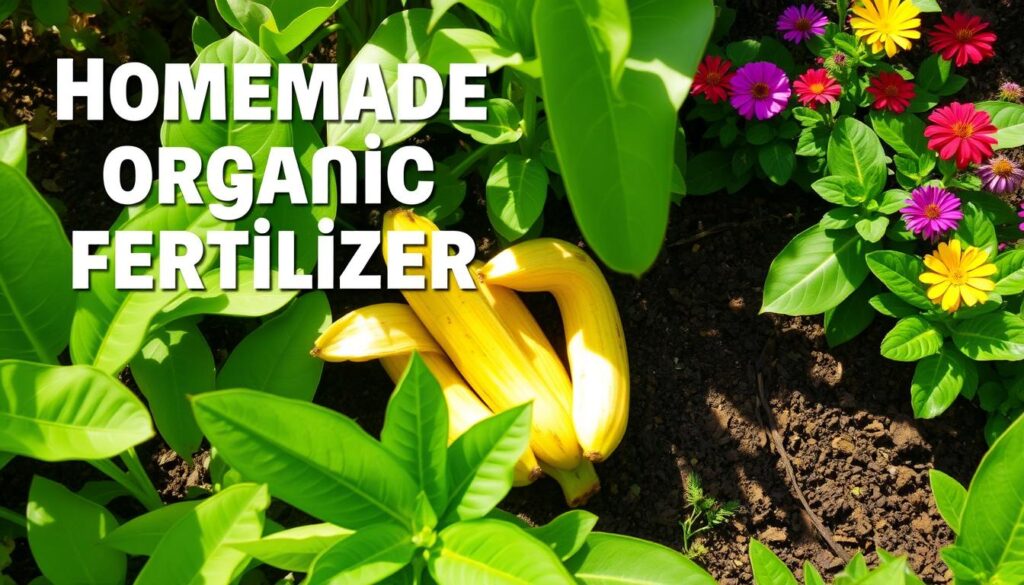
Adding banana peels to your garden helps reduce waste and creates a natural fertilizer. It also supports healthy plant growth. With these easy tips, you can start using banana peels in your garden today.
| Benefits of Banana Peels | Description |
|---|---|
| Promotes Healthy Plant Growth | Banana peels are rich in nutrients that promote healthy plant growth and development. |
| Improves Soil Fertility | The nutrients in banana peels can improve soil fertility, making it easier to grow a variety of plants. |
| Natural Pest Repellent | Banana peels can be used as a natural pest repellent to keep aphids and other pests away from your plants. |
Creating Liquid Organic Fertilizers
Liquid organic fertilizers are easy and effective for your plants. Compost tea is a favorite, made by soaking compost in water. This creates a nutrient-rich liquid full of good microbes.
Fermented plant juice is another great option. It’s made by fermenting plants in water. This liquid is full of nutrients and microbes, perfect for your plants.
Compost Tea Basics
To make compost tea, start with good compost. Use a 1:10 compost to water ratio. Let it steep for 24-48 hours. This allows microbes and nutrients to mix well.
Fermented Plant Juice
Fermented plant juice is made by fermenting plants in water. It takes days to weeks, depending on the plants and desired fermentation. The result is a nutrient-rich liquid, great for plants.
Storage and Application Tips
Keep liquid fertilizers cool and dark to avoid bad microbes. You can spray them on plants, soak the soil, or use drip irrigation. Always dilute the fertilizer in water before use. Undiluted solutions can harm plant roots.
| Type of Fertilizer | Benefits | Application Method |
|---|---|---|
| Compost Tea | Rich in beneficial microorganisms and nutrients | Foliar spraying, soil drenching |
| Fermented Plant Juice | Rich in nutrients and beneficial microorganisms | Soil drenching, drip irrigation |
Common Mistakes to Avoid When Making Organic Fertilizer
Making organic fertilizer can be a fun and rewarding experience. But, it’s important to know the common mistakes to avoid. One big error is using the wrong ingredient ratios. This can make the fertilizer not work well and even harm your plants.
Proper Ingredient Ratios
To avoid this mistake, it’s key to know the right ingredient ratios. A good rule is to mix “green” materials like food scraps and grass clippings with “brown” materials like dried leaves and twigs. Aim for a mix of 2/3 “brown” materials and 1/3 “green” materials.
Storage Issues
Another mistake is not storing the fertilizer right. This can cause contamination, spoilage, and bad smells. To prevent these issues, keep your organic fertilizer in a well-ventilated spot. Make sure it’s away from direct sunlight and moisture.
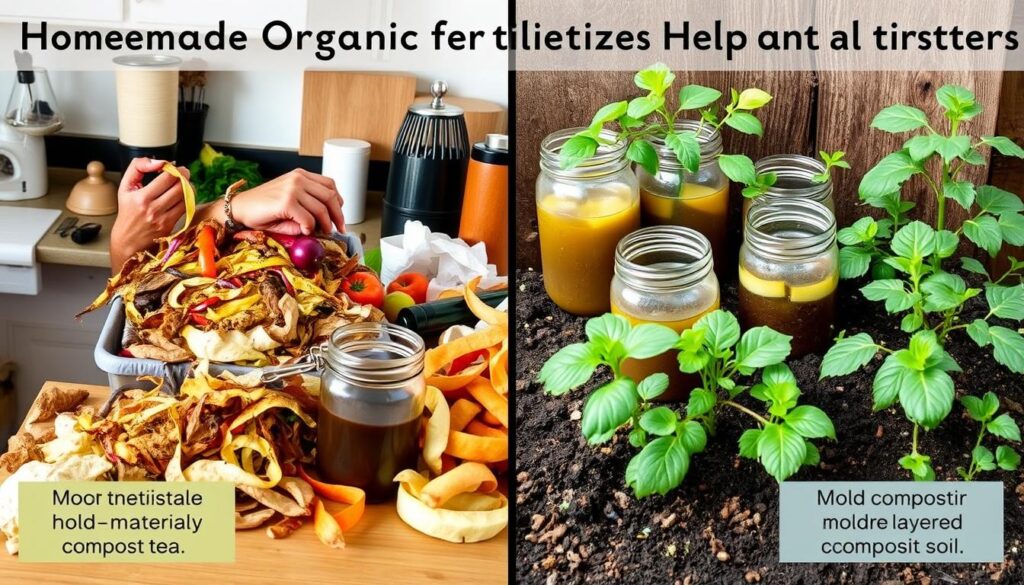
Knowing these common mistakes can help you make a good organic fertilizer for your plants. Always use the right ingredient ratios and store it correctly to avoid problems.
| Mistake | Consequence | Solution |
|---|---|---|
| Improper ingredient ratios | Ineffective fertilizer or plant harm | Use a 2/3 “brown” materials and 1/3 “green” materials ratio |
| Storage issues | Contamination, spoilage, or unpleasant odors | Store in a well-ventilated area, away from direct sunlight and moisture |
Best Practices for Applying Homemade Fertilizers
Applying homemade fertilizers needs careful steps to help your plants grow well. Proper application is key to prevent harming your plants. First, pick the right fertilizer for your plants, thinking about their needs and the season.
Some application tips to remember include using fertilizers when plants are growing. Also, stick to the recommended amount and don’t overdo it. Fertilizer safety is important to avoid soil and water pollution.
- Always read and follow the instructions for your specific fertilizer
- Wear protective gloves and eyewear when handling fertilizers
- Keep fertilizers out of reach of children and pets
By following these best practices for applying homemade fertilizers, you can create a healthy garden. Always put fertilizer safety first and follow application tips for the best results.
Conclusion: Nurturing Your Garden Naturally
Making and using homemade organic fertilizer is a great way to care for your garden. By following the tips in this article, you can make your garden healthy and sustainable. This approach avoids harmful chemicals and helps the environment.
Using homemade organic fertilizers does more than just feed your plants. It also supports the ecosystem’s balance. These methods enrich the soil, attract good insects, and lower your environmental impact. As you work towards a greener garden, remember to use nature’s power and go back to organic gardening’s roots.

